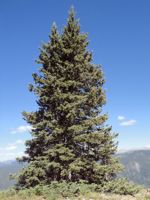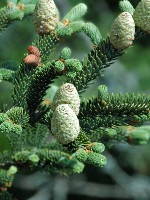Mon-Fri 9am - 5pm Mountain time
Douglas Fir vs Fraser Fir
Pseudotsuga menziesii var. glauca
Abies fraseri
Douglas Fir is a large coniferous tree with a pyramidal shaped crown.
This attractive feature tree, with its distinctive drooping cones, is perfect for any grower who has lots of space and lives in a warm enough region. Douglas Firs make exceptional Christmas trees.
It is not suitable to all growing environments. Do some research and make sure this tree is right for you.
Our seed source is typically from the interior of BC and rocky mountain areas. We do not produce coastal seed source Douglas Fir as it is better suited to its native range and some taxonomists believe the two seed sources might be distinct.
Fraser Fir is a great choice for a Christmas tree, or as an addition to your landscape. It retains its needles when cut, has good branch strength, and grows into the classic conical Christmas tree shape. When the cones are young they emerge purple, which adds an additional splash of colour to the tree.
Fraser Fir may suffer in warmer climates, we do not recommend this tree in hardiness zones 7 or higher. It is very similar to Balsam Fir, and can freely be used as a substitute.

